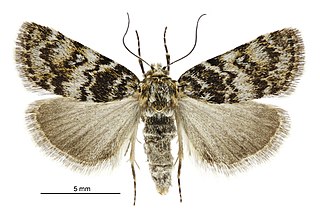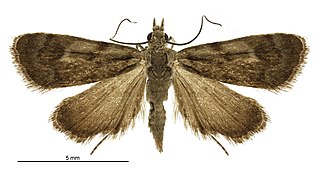
The Royal Society of Victoria (RSV) is the oldest scientific society in Victoria, Australia.
Delogenes is a monotypic snout moth genus. Its only species, Delogenes limodoxa, is found in New Zealand. Both the genus and species were described by Edward Meyrick in 1918.

Glaphyriinae is a subfamily of the lepidopteran family Crambidae. It was described by William Trowbridge Merrifield Forbes in 1923. The subfamily currently comprises 509 species in 75 genera.
Eurhythma polyzelota is a moth in the family Crambidae. It was described by Turner in 1913. It is found in Australia, where it has been recorded from the Northern Territories.
Eurhythma xuthospila is a moth in the family Crambidae. It was described by Turner in 1913. It is found in Australia, where it has been recorded from the Northern Territories.

Tauroscopa notabilis is a moth in the family Crambidae. It was described by Alfred Philpott in 1923. It is endemic to New Zealand.
Ubida amochla is a moth in the family Crambidae. It was described by Turner in 1922. It is found in Australia, where it has been recorded from Queensland.

Glaucocharis stella is a species of moth in the family Crambidae. It is endemic to New Zealand.

Pyrausta comastis is a moth in the family Crambidae. This species is endemic to New Zealand. It has been classified as "nationally vulnerable" by the Department of Conservation.
Dasyscopa homogenes is a moth in the family Crambidae. It was described by Edward Meyrick in 1894. It is found in India and on Sumbawa in Indonesia.
Notocrambus holomelas is a moth in the family Crambidae. It was described by Turner in 1922. It is found in Australia, where it has been recorded from Tasmania.
Scoparia ischnoptera is a moth in the family Crambidae. It was described by Turner in 1922. It is found in Australia, where it has been recorded from Victoria.
Scoparia leucomela is a moth in the family Crambidae. It was described by Oswald Bertram Lower in 1893. It is found in Australia, where it has been recorded from South Australia and Western Australia.
Scoparia platymera is a moth in the family Crambidae described by Oswald Bertram Lower in 1905. It is found in Australia, where it has been recorded from Tasmania.
Hydrorybina pryeri is a moth in the family Crambidae. It was described by Arthur Gardiner Butler in 1881. It is found in Japan and Russia.
Metasia strangalota is a moth in the family Crambidae. It was described by Edward Meyrick in 1887. It is found in Australia, where it has been recorded from New South Wales.

Nacoleia mesochlora is a moth in the family Crambidae. It was described by Edward Meyrick in 1884. It is found in Australia, where it has been recorded from Queensland, the Northern Territory, New South Wales, Victoria, South Australia and Western Australia.
Syllepte invalidalis is a moth in the family Crambidae. It was described by South in 1901. It is found in China.
Eutorna epicnephes is a moth in the family Depressariidae. It was described by Edward Meyrick in 1906. It is found in Australia, where it has been recorded from Victoria, New South Wales and Queensland.
Eutorna rubida is a moth in the family Depressariidae. It was described by Alfred Jefferis Turner in 1919. It is found in Australia, where it has been recorded from Victoria.





